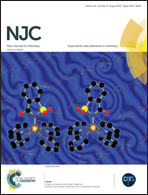Application of an optimized electrochemical sensor for monitoring astaxanthin antioxidant properties against lipoperoxidation†
Abstract
An optimized electrochemical sensor was developed to assess the antioxidant capacity of carotenoids, accumulating during the life cycle of Haematococcus pluvialis cell cultures. The sensor was improved with a composite renewable surface made of immobilised phosphatidylcholine (PC) on magnetic nanobeads of iron oxide (Fe3O4) and PC/Fe3O4, and it was used to monitor the antioxidant properties of the ketocarotenoid astaxanthin against in situ generated phosphatidylcholine lipoperoxides. The surface configuration was able to mimic the natural position and orientation of astaxanthin in the cellular membrane, conferring to the whole experimental set-up good sensitivity for reactive oxygen species (limit of detection for peroxyl radicals 9.1 × 10−10 mol L−1) with a linear response ranging between 10−8 and 1.6 × 10−6 mol L−1. The sensor has been proved suitable for both batch and flow measurements. The accuracy of the flow measurements was unaffected by the magnetic field intensity. Electrochemical measurements confirmed that natural astaxanthin is a more effective antioxidant than synthetic astaxanthin, vitamin E and lutein and the protective effect of astaxanthin correlates with its concentration inside the cell. The newly developed sensor is hence useable for in-line monitoring of whole-cell based industrial bioprocesses for the production of astaxanthin.


 Please wait while we load your content...
Please wait while we load your content...